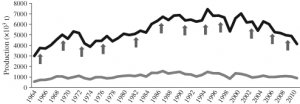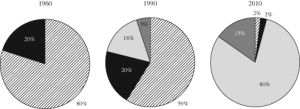Current and Future Conservation Efforts for the Critically Endangered Smalltooth Sawfish (Pristis pectinata)
by Laurel Zaima, RJD Intern
The endangerment and extinction of many plant and animal species is often due to a direct anthropogenic impact on the environment. If humans cause the endangerment of a species, humans should be held responsible for recovery of that species. Unfortunately, this is the case for the incredibly unique elasmobranch, the smalltooth sawfish (Pristis pectinata). The smalltooth sawfish populations began globally declining during the mid to late 20th century due to a variety of irresponsible anthropogenic practices (“Pristis pectinata”). International and national conservation actions have been taken in the past ten years to help prevent the sawfish from becoming extinct; however, the smalltooth sawfish is still considered critically endangered. The smalltooth sawfish has the potential to be removed from the International Union for Conservation of Nature (IUCN) endangered red list if more research is gathered to better develop conservation programs, and if the current conservation laws are enforced and enacted by the public.
The morphology of the smalltooth sawfish has an indirect influence on the depletion of the sawfish population. Smalltooth sawfish average a weight of 350 kilograms, a length of 5.5 – 7 meters, and an age of 25-30 years (“Smalltooth Sawfish”). Similar to many sharks, the smalltooth sawfish have a low reproductive rate because they grow slow, mature at a late age, and produce few young per liter (“Sawfish Facts”). These characteristics make it difficult for the smalltooth sawfish populations to recover in a timely manner, especially when they are subject to anthropogenic threats (“Sawfish Facts”). The smalltooth sawfish, as suggested, is known for their “saws,” also known as a rostrum, which are long, flat snouts edged with pairs of teeth that they use to locate, stun, and kill their prey (“Sawfish-Cousins of the Shark”).
The smalltooth sawfish’s large size and the protruding rostrum make them especially vulnerable to bycatch by various fishing gear. Net fishing gear, especially gillnets and trawl nets, have high tendency to tangle around the rostrum of the sawfish (“Sawfish Facts”). Occasionally, fishermen will kill the sawfish before they were removed from the fishing gear in order to prevent damage to the fishing gear or danger to the fisherman (“Smalltooth Sawfish”). During the 1970s, recreational and commercial fishers would catch smalltooth sawfish mainly for their meat (“Sawfish-Cousins of the Shark”).

Historically, fishermen easily caught smalltooth sawfish for meat using a variety of fishing gear, including gill nets and trawl nets.
Today, sawfish are intentionally caught less for their meat, but more for the value of their saws, fins, and teeth in the illegal wildlife trade (“Sawfish-Cousins of the Shark”).
Anthropogenic habitat degradation has also contributed to the exponential decline of the smalltooth sawfish population, and it has tremendously limited their habitat distribution. Smalltooth sawfish inhabit shallow coastal waters with muddy, sandy bottoms of the tropical sea, estuaries, and mangroves (“Smalltooth Sawfish”). Extensive habitat modifications and losses of the smalltooth sawfish is directly caused by agricultural and urban development, commercial activities, dredge-and-fill operations, boating erosion, and diversion of freshwater runoff from coastal and catchment development (“Pristis pectinata”). A study by Simpfendorfer, Wiley, and Yeiser (2010) used active tracking and passive acoustic monitoring of the juvenile smalltooth sawfish in order to understand the fine scale movements and habitat in southwest Florida. Shallow banks close to estuaries and mangrove shorelines were found to be especially important nursery areas for juvenile smalltooth sawfish (Simpfendorfer, Wiley, Yeiser, 2010). Unfortunately, much of these areas have been damaged or lost due to human development. The loss of nursery areas declines the smalltooth sawfish reproductive ability and prevents this species from restoring their population. The acoustic telemetry data collected by C. A. Simpfendorfer of the Mote Marine Laboratory (2001) indicates that smalltooth sawfish in the Everglades National park had high levels of site fidelity and preferred to inhabit an area for months. Since sawfish do not regularly migrate, the destruction of shallow coastal waters, estuaries, and mangroves can increase the levels of mortality of the sawfish in that area.
The smalltooth sawfish once flourished international waters, but habitat loss has nearly extirpated their distribution range. Historically, the smalltooth sawfish populated U.S. waters ranging from the Gulf of Mexico (Texas to Florida), and along the east coast from Florida to Cape Hatteras; internationally, the smalltooth sawfish populated South Africa, Madagascar, the Red Sea, Arabia, India, the Philippines, along the coast of West Africa, portions of South America, Ecuador, the Caribbean Sea, the Mexican Gulf of Mexico, and Bermuda (“Smalltooth Sawfish”). The global and U.S. distribution of sawfish is estimated to have profoundly declined. The smalltooth sawfish is currently found in the southeastern U.S., specifically Florida, the Bahamas, Cuba, Honduras, and Belize (“Pristis pectinata”). The distribution of smalltooth sawfish in other parts of the world is uncertain because there is a lack of population surveys and biological research towards this species (“Pristis pectinata”). While the presence of sawfish is ambiguous, major anthropogenic threats and few local population surveys serve as evidence to suggest that the distribution range and population of sawfish has drastically decreased.
Currently, international and national conservatory action has been enacted in hopes to restore the smalltooth sawfish population. The United States has initiated a variety of programs that spread awareness of the smalltooth sawfish endangerment, educate to the public regarding their population status, and conserve and protect the smalltooth sawfish. The Smalltooth Sawfish Recovery Team is comprised of scientists, managers, and environmental managers that plan to recover the U.S. population of the smalltooth sawfish (“Smalltooth Sawfish”). The Smalltooth Sawfish Recovery team collaborated with the National Marine Fisheries Service (NMFS) to formulate the final recovery plan in January 2009, which strives to reduce fishing impacts, protect important habitats, educate the public, and provide guidelines to fishermen on safely handling and releasing sawfish (“Smalltooth Sawfish”). In 2003, the Endangered Species Act (ESA) listed the smalltooth sawfish as the first elasmobranch classified as endangered (“Sawfish Facts”). The protection under the ESA means that it is illegal to harass, harm, pursue, hunt, shoot, wound, kill, trap, capture, or attempt to engage in any form of contact with a smalltooth sawfish (“Pristis pectinata”). The ESA has been able to provide a framework for the conservation and recovery of the smalltooth sawfish by better protecting the species and their habitats throughout the U.S. In 2009, the National Marine Fisheries Service established a critical habitat for juvenile smalltooth sawfish in the U.S., which is designed to facilitate recruitment into the adult sawfish population by protecting juvenile nursery areas (“Pristis pectinata”). Within the U.S., Florida, Louisiana, and Texas have prohibited the “take” of sawfish, and Florida banned the use of gill nets in state waters and established three national wildlife refuges to protect the smalltooth sawfish habitat (“Smalltooth Sawfish”). The quick and extensive conservative action taken by the U.S. has allowed the smalltooth sawfish population to stabilized in national waters.
Internationally, conservative action towards the smalltooth sawfish has also been implemented. All species of sawfish are listed on Appendix I of the Convention on International Trade in Endangered Species of Wild Fauna and Flora (CITES), which bans the commercial international trade of sawfish or sawfish parts (“Pristis pectinata”). Individual countries have taken personal conservatory action towards the protection of the smalltooth sawfish. Nicaragua imposed a permanent ban on targeted sawfish fishing in Lake Nicaragua; Brazil has protected the smalltooth sawfish by the Ministry of Environment; Mexico has banned the take of all sawfish; sawfish are protected under the Exclusive Economic Zone in Guinea and Senegal, and in the marine protected areas in Mauritania and Guinea-Bissau (“Pristis pectinata”). Although there are many programs, strategies, and laws that strive to protect the smalltooth sawfish, this species is still considered critically endangered. Therefore, further action must be taken in hopes to recover the smalltooth sawfish population and to stabilize their species.
In order for the smalltooth sawfish species to bounce back from critical endangerment, more research and population surveys needs to be globally conducted, and the conservation programs that are already initiated must be enforced. Further information regarding the distribution and abundance of the smalltooth sawfish needs to be collected more frequently, and across a larger area to obtain an accurate estimation of the species population. A smalltooth sawfish study conducted by C. A. Simpfendorfer of the Mote Marine Laboratory (2001) successfully surveyed south Florida to determine the distribution and abundance, utilized acoustic and satellite telemetry to investigate movements and habitat utilization, used the public reporting database to gather data on sawfish encounters by the public, and studied the population dynamics and conservation genetics to investigate how the population decline has impacted the genetic diversity.
This research provides useful information about the smalltooth sawfish, but unfortunately, it is limited to the southern Florida area. More research, similar to this study, must be conducted worldwide to fully understand the sawfish population and to create effective conservation programs for this species. According to a study performed by Carlson et al. (2012), there is little scientific research about the sawfish critical habitats and the environmental conditions of these habitats; however, there are large amounts of nontraditional data that comes from public encounters voluntarily reported to members of the recovery team. The nontraditional data is helpful in obtaining an idea of the smalltooth sawfish habitats, but this data is not as reliable as scientific research. Unfortunately, the immediate need to protect the smalltooth sawfish habitat by the ESA and a lack of research resulted in the use of the nontraditional data to designate critical habitats (Carlson et al., 2012). There is an imperative need for more scientific research about the smalltooth sawfish habitat and their movement patterns in order to accurately initiate protective strategies. Some additional policy and conservative recommendations include: training local fisheries to conduct sawfish surveys in key regions including West Africa, Borneo, Brazil, India, and Papua New Guinea; helping key regions develop national and regional plans to recover sawfish; creating sawfish identification manuals to aid fishermen, customs agents, and enforcement personnel in preventing illegal trade; reducing sawfish bycatch in trawl and gillnet fisheries around the world (“Sawfish-Cousins of the Shark”).
Although significant progress has been made towards the conservation of the smalltooth sawfish, there is still a lot of research and conservatory action that needs to occur. If expedite action is taken, the smalltooth sawfish can avoid extinction and be removed from the IUCN critically endangered list.
REFERENCES
Carlson, J. K. et al. 2012. “Designating Critical Habitat for Juvenile Endangered Smalltooth Sawfish in the United States.” Marine and Coastal Fisheries: Dynamics, Management, and Ecosystem Science 4: 473-480.
“Pristis pectinata.” The IUCN Red List of Threatened Species. n.p., 2013. Web. 7 Oct. 2013.
“Sawfish-Cousins of the Shark.” NOAA Fisheries. n.p., 15 Aug. 2012. Web. 7 Oct. 2013.
“Sawfish Facts.” MOTE Marine Laboratory. n.p., 2012. Web. 7 Oct. 2013
Simpfendorfer, Colin A. (2001). Occurrence and Movements of Sawfish in Southern Florida. National Geographic Society’s Committee for Research and Exploration: Sarasota, Florida. 787.
Simpfendorfer, Colin A., Wiley, Tonya R., Yeiser, Beau G. 2010. “Improving Conservation Planning for an endangered Sawfish using data from Acoustic Telemetry.” Biological Conservation 143: 1460-1469.
“Smalltooth Sawfish.” NOAA Fisheries Office of Protected Resources. n.p., 26 Aug. 2013. Web. 7 Oct. 2013.







